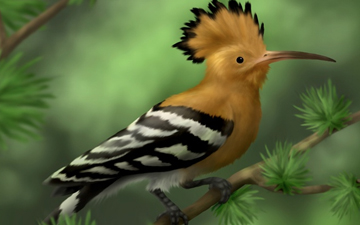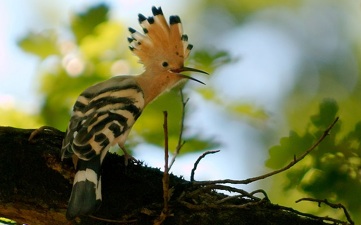The Hoopoe (![]() /ˈhuːpuː/) (Upupa epops) is a colourful bird that is found across Afro-Eurasia, notable for its distinctive ‘crown’ of feathers. Like the Latin name upupa, the English name is an onomatopoetic form which imitates the cry of the bird.
/ˈhuːpuː/) (Upupa epops) is a colourful bird that is found across Afro-Eurasia, notable for its distinctive ‘crown’ of feathers. Like the Latin name upupa, the English name is an onomatopoetic form which imitates the cry of the bird.
The Hoopoe is classified in the Coraciiformesclade, a group that also includes kingfishers, bee-eaters, rollers, and woodhoopoes (forming a clade with this one according to Hackett et al. (2008)[2]).
The Hoopoe is widespread in Europe, Asia, and North Africa, Sub-Saharan Africa and Madagascar.[6] Most European and north Asian birds migrate to the tropics in winter.[8] In contrast the African populations are sedentary year-round. The species has been a vagrant in Alaska;[9] U. e. saturata was recorded as being seen there in 1975 in the Yukon Delta.[10] Hoopoes have been known to breed north of their European range,[11] and in southern England during warm, dry summers that provide plenty of grasshoppers and similar insects,[12] although as of the early 1980s northern European populations were reported to be in the decline possibly due to changes in climate.[11]
The Hoopoe has two basic requirements in its habitat; bare or lightly vegetated ground on which to forage and vertical surfaces with cavities (such as trees, cliffs or even walls, nestboxes, haystacks, and abandoned burrows[11]) in which to nest. These requirements can be provided in a wide range of ecosystems and as a consequence they inhabit a wide range of habitats from heathland, wooded steppes, savannas and grasslands, as well as glades inside forests. The Madagascar subspecies also makes use of more dense primary forest. The modification of natural habitats by humans for various agricultural purposes has led to them becoming common in olive groves, orchards, vineyards, parkland and farmland, although they are less common and declining in intensively farmed areas.[6] Hunting is of concern in southern Europe and Asia.[10]
Hoopoes make seasonal movements in response to rain in some regions such as in Ceylon and in the Western Ghats.[13] Birds have been seen at high altitudes during migration across the Himalayas and was recorded at about 6400 m by the first Mount Everest Expedition.[14]
The Hoopoe is a medium sized bird, 25–32 cm (9.8–12.6 in) long, with a 44–48 cm (17.3–19 in) wingspan weighing 46–89 g (1.6–3.1 oz). The species is highly distinctive, with a long, thin tapering bill that is black with a fawn base. The strengthened musculature of the head allows the bill to be opened when probing inside the soil. The hoopoe has broad and rounded wings capable of strong flight; these are larger in the northern migratory subspecies. The Hoopoe has a characteristic undulating flight, which is like that of a giant butterfly, caused by the wings half closing at the end of each beat or short sequence of beats.[6]
The call is typically a trisyllabic “oop-oop-oop”, which gives rise to its English and scientific names, although two and four syllables are also common. In the Himalayas, the calls can be confused with that of the Himalayan Cuckoo (Cuculus saturatus) although the cuckoo typically produces four notes. Other calls include rasping croaks, when alarmed, and hisses. A wheezy note is produced by females during courtship feeding by the male.[14]
The diet of the Hoopoe is mostly composed of insects, although small reptiles and frogs as well as some plant matter such as seeds and berries are sometimes taken as well. It is a solitary forager which typically feeds on the ground. More rarely they will feed in the air, in pursuit of numerous swarming insects, where their strong and rounded wings make them fast and manoeuvrable. More commonly their foraging style is to stride on relatively open ground and periodically pause to probe the ground with the full length of their bill. Insect larvae, pupae and mole crickets are detected by the bill and either extracted or dug out with the strong feet. In addition to feeding in soil Hoopoes will feed on insects on the surface, as well as probing into piles of leaves and even using the bill to lever large stones and flake off bark. Common diet items include crickets, locusts, beetles, earwigs, cicadas, ant lions, bugs and ants. These can range from 10 to 150 mm in length, with the preferred size of prey being around 20–30 mm. Larger prey items are beaten against the ground or a preferred stone in order to kill them and remove indigestible body parts such as wings and legs.[6]
The diet of the Hoopoe includes many species considered to be pests by humans; for example the pupae of the processionary moth, a damaging forest pest.[19] For this reason the species is afforded protection under the law in many countries.[6]
Hoopoes are distinctive birds and have made a cultural impact over much of their range. They were considered sacred in Ancient Egypt, so they were “depicted on the walls of tombs and temples”. They achieved a similar standing in Minoan Crete.[15]
Hoopoes were seen as a symbol of virtue in Persia. A hoopoe was the leader of the birds in the Persian book of poems The Conference of the Birds.
They were thought of as thieves across much of Europe and harbingers of war in Scandinavia.[21] Also, in Estonian tradition the Hoopoes are strongly connected with death and the underworld, their song is seen as a forebode of death for many a people or cattle.[22]
The Hoopoe was chosen as the national bird of Israel in May 2008 in conjunction with the country’s 60th anniversary, following a national survey of 155,000 citizens, outpolling the White-spectacled Bulbul.[26] It is also the state-bird of Punjab province of India. The Hoopoe appears on the Logo of the University of Johannesburg, and is the official mascott of the University’s sports. The municipality of Armstedt, Germany has a hoopoe in its coat of arms.
(From Wikipedia, 22 June 2012)





